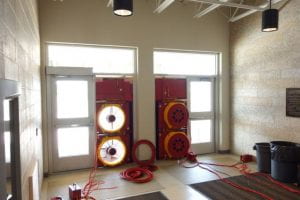Fort Whyte Alive – Air Leakage Testing
The objective of this applied research project is to conduct airtightness testing on the interpretive centre at Fort Whyte Alive, located in southwest Winnipeg.
Background
The interpretive centre will be undergoing a major envelope upgrade that is projected to take place in 2016.
Services Provided
- The project will involve the testing of the existing building prior to the renovations as well as comparative testing after the work has been completed.
- During the pre-renovation test, major leakage paths will be identified through the use of diagnostic tools such as smoke machines and infrared thermography.
Results
- The results of the pre-renovation testing, which was completed in December 2015, will help guide the scope of work for the retrofits.
An article about the pre-renovation testing was published in the Globe and Mail.




 There is a growing recognition of the need to establish performance targets for the airtightness of buildings either through regulations or voluntary programs. Before this occurs, further research is required to establish baseline air leakage rates and appropriate building airtightness targets (and, for specific building types/uses such as schools).
There is a growing recognition of the need to establish performance targets for the airtightness of buildings either through regulations or voluntary programs. Before this occurs, further research is required to establish baseline air leakage rates and appropriate building airtightness targets (and, for specific building types/uses such as schools).